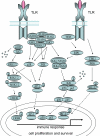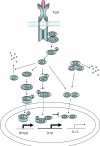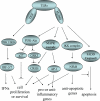Toll-like receptor signaling in cell proliferation and survival
- PMID: 19775907
- PMCID: PMC2808458
- DOI: 10.1016/j.cyto.2009.08.010
Toll-like receptor signaling in cell proliferation and survival
Abstract
Toll-like receptors (TLRs) are important sensors of foreign microbial components as well as products of damaged or inflamed self tissues. Upon sensing these molecules, TLRs initiate a series of downstream signaling events that drive cellular responses including the production of cytokines, chemokines, and other inflammatory mediators. This outcome results from the intracellular assembly of protein complexes that drive phosphorylation and other signaling cascades ultimately leading to chromatin remodeling and transcription factor activation. In addition to driving inflammatory responses, TLRs also regulate cell proliferation and survival which serves to expand useful immune cells and integrate inflammatory responses and tissue repair processes. In this context, central TLR signaling molecules, such as the mitogen-activated protein kinases (MAPK) and phosphoinositide 3-kinase (PI3K), play key roles. In addition, four major groups of transcription factors which are targets of TLR activation also control cell fate. This review focuses on the role of TLR signaling as it relates to cell proliferation and survival. This topic not only has important implications for understanding host defense and tissue repair, but also cancer which is often associated with conditions of chronic inflammation.
Copyright 2009 Elsevier Ltd. All rights reserved.
Figures



References
-
- Akira S, Takeda K. Toll-like receptor signalling. Nat.Rev.Immunol. 2004;4:499–511. - PubMed
-
- Banerjee A, Gerondakis S. Coordinating TLR-activated signaling pathways in cells of the immune system. Immunol.Cell Biol. 2007;85:420–4. - PubMed
-
- Wagner H. Endogenous TLR ligands and autoimmunity. Adv.Immunol. 2006;91:159–73. - PubMed
-
- Hasan UA, Trinchieri G, Vlach J. Toll-like receptor signaling stimulates cell cycle entry and progression in fibroblasts. J.Biol.Chem. 2005;280:20620–7. - PubMed
-
- Jego G, Bataille R, Geffroy-Luseau A, Descamps G, Pellat-Deceunynck C. Pathogen-associated molecular patterns are growth and survival factors for human myeloma cells through Toll-like receptors. Leukemia. 2006;20:1130–7. - PubMed
Publication types
MeSH terms
Substances
Grants and funding
LinkOut - more resources
Full Text Sources
Other Literature Sources

